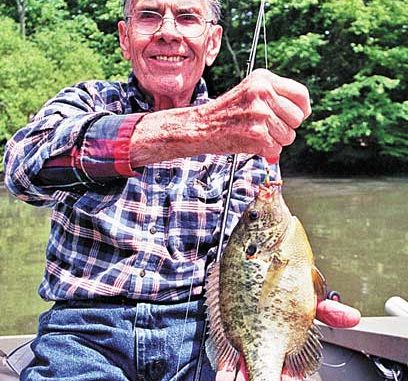
There is so much technical equipment and electronic fishing aids available these days, it’s easy to get caught up in the thrill of the gizmos. That’s exciting, but sometimes fishermen miss the big picture of just having fun fishing the old-fashioned way on Lake Marion and Lake Moultrie.
There’s no better time on these lakes to fish for fun than May. The weather is ideal, and lots of different species are biting. A prime example of fun-fishing is reverting to ultralight tackle or just a long pole and live bait. Rigged with this simple gear, many Santee Cooper fishermen enjoy bream and shellcracker fishing at its finest.
Chuck Porter loves to target largemouth bass and catfish, but he takes time out during May to hunt down bream beds for pure fishing pleasure.
“I’ve found dependable places for bream beds during the years, but I enjoy the searching process almost as much as the catching,” Porter said. “If I hit a hot bed and limit quickly one day, I’ll go straight back there on the next trip. But often, I’ll have to hunt them down. I’ll get the boat in water from very shallow down to four or five feet deep. Using ultralight tackle or a Bream Buster rigged with a small float and No. 6 wire hook, I simply work along the shoreline and cypress trees. I prefer areas that have some different depths of water, but not a steep drop, for bedding action. I’ll alternate between worms and crickets as bait.
“Typically by May, the best bed fishing is for bream,” he said. “But good bed-fishing for shellcrackers still occurs. I’ll typically use crickets as my searching bait, but if I hook a big shellcracker, I will bait up with worms, and the shellcracker action is on.”
Porter said that bream-bed fishing action is as enjoyable as any type of fishing.
“Bream-bed fishing on Santee Cooper is a great way to get mentally consumed in the act of catching lots and lots of fish,” he said. “It’s a prime way to introduce newcomers, especially kids, to the sport of fishing.”
Porter said that it’s a good idea to begin culling small fish quickly or you’ll likely soon have a limit of bream and have to quit too early. Hitting a hot bream bed is about as good as spring fishing can get. And it’s nigh impossible to worry and watch a cork on a bream bed at the same time. Try it, you’ll see.
Catfish on the prowl
While bream and shellcrackers provide great fighting ability for their size, catfish are at the other end of the size spectrum. Big blue and flathead catfish are caught that test the limits of freshwater tackle.
Capt. Darryl Smith is a full-time catfishing guide (803-324-7912),who has a gameplan for catching big catfish during May.
“One key is to follow the migrating fish, so I will often fish either or both lakes Marion and Moultrie,” Smith said. “By May, I believe the majority of the big blues have spawned.”
For post-spawn blues this month, Smith prefers areas where ridges and humps come within 10 feet of the surface. He’ll usually drift-fish from deep water onto the hump and back into deep water, or he will anchor and fan cast the area.
“I’ll often use gizzard shad or herring as bait,” he said. “Sometimes, I’ll catch bream and white perch and use them as cut bait when drift fishing.
“Also during May, there’s a lot of catfish caught in the (Diversion) Canal between the lakes,” Smith said. “This is a prime time to hook a big flathead, especially at night. Flatheads tend to seek out deep holes in the Canal. It may only be a foot or two deeper than surrounding water, but it is enough to hold these fish. Anchor above the spot you intend to fish and cast back to it. I use bream, white perch or gizzard shad as bait.
“Expect big blue and flathead catfish to bite big-time during May,” Smith said.
Tight lines and tangled dipnets
Use the right tackle for the fish you’re targeting. Ultra-light tackle is ideal for bream and shellcracker fishing, but using tiny tackle on Santee catfish will likely lead to broken lines and broken hearts when that monster swims off.
One final thought. Fishermen get frustrated coping with the drought-high water-drought pattern on the Santee Cooper reservoirs in recent years. But it’s not all bad. One good thing about the high water earlier this spring is the hope of better spawns for species such as crappie, bass and bream. Plus, the “river rats” fishing the Santee River below the dam were glad to get the extra water. Once the river stabilizes, the fishing is usually much better throughout the spring and summer.
Go fishing now; it’s time to have some fun.




Be the first to comment